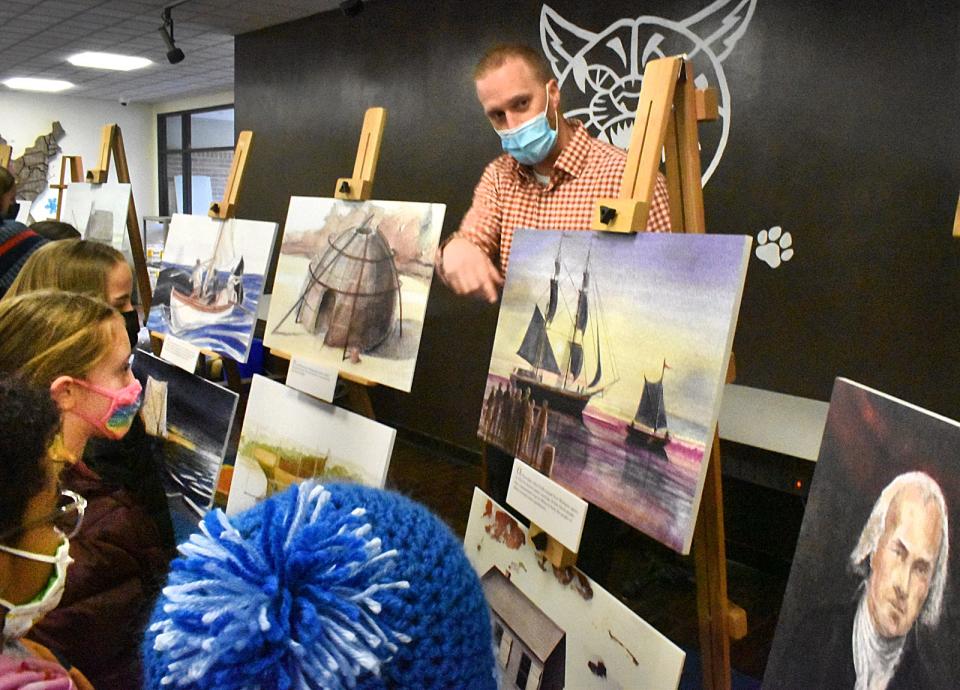The first racially-integrated school in the US was in Westport. Here's how it happened.
- Oops!Something went wrong.Please try again later.
WESTPORT — The first racially integrated school in the country was in town.
It only makes sense that the Westport Historical Society and the Westport Elementary School team up to celebrate the 253rd birthday of the man who helped make it happen: Paul Cuffe.
Fittingly, just before Martin Luther King Jr. Day, community members and school children gathered on Friday to celebrate the birthday of this famous Quaker man who fought against slavery and sought out tolerance during his time:1759-1817.
Cuffe was of African American and Native American descent, born on Cuttyhunk Island and later making his home in Westport.
Carl Cruz, a member of the New Bedford Historical Society and a descendant of Cuffe, gave a presentation on why Cuffe’s birthday — Jan. 17 — calls for a community celebration.

Cuffe, one of 10 children, moved to this area when Cuffe was 8 and quickly began to make his mark on the area.
Cuffe took to seafaring, and at 14 embarked on his first whaling voyage to the West Indies.
Helping out: 'Betty White challenge' boosts Fall River animal shelters
Two years later, Cuffe embarked on a second whaling journey and produced income to help his family at home. His father died when Cuffe was a teen. Cuffe and his brothers were responsible for the 116-acre farm, only a mile from the WES building.
Cuffe starts a shipping business
His journeys along the Atlantic were not all fun. During the Revolutionary War, he was captured by British forces and held for three months in New York as a prisoner of war, according to Cruz
He was “one of four people of color” to petition the state Legislature to allow people of color to vote in local elections.
Cuffe started his own shipping business along the west bank of the Westport River. There he built five large whaling ships used for whaling, fishing and transporting goods along the Atlantic Ocean.
Cuffe married a Native American woman, Alice Abel Pequit, in 1783. They had seven children and lived near the shipyard.
Cuffe built a school house on Drift Road, hired a teacher and “established the first integrated school — for Black and white — in the country.
Enjoy winter: Fall River's Bioreserve is ideal for winter hiking. Here's how to start and where to go
“He became the richest man of color in New England,” Cruz said.
In 1808, he was admitted as a member of the town’s Quaker Friends group, which still exists to this day.
Cuffe also sailed to Sierra Leone in Africa and then to England in an effort to stop the slave trade.
He was also the first person of color to meet with an American president, according to Cruz. His resume does not stop there. He helped build the Quaker Meeting house in Westport, he returned to Sierra Leone after the War of 1812 to rescue Black families and he set up a smallpox hospital in town.
Betty Slade, of Westport’s Historical Society, said that the first birthday celebration of Cuffe happened two years ago, right before the pandemic started.
All four WES grades gathered this year to celebrate this birthday and the town’s appreciation for this famous captain doesn’t stop there.
A book was released last year — "Paul Cuffe: His Purpose, Partners and Properties" by David Cole, Betty Slade, Richard Gifford and illustrated by Ray Shaw.
A website in his honor can be found at https://paulcuffe.org/
This article originally appeared on The Herald News: Westport's Captain Paul Cuffe was a pioneer in racial equality

